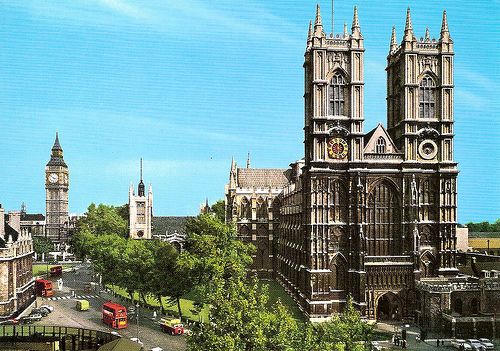Westminster Abbey
Westminster Abbey is built upon what was once Thorney Island which is a marshy retreat from the City of London. In 604 AD, St. Paul’s was founded in the city of London by Ethelbert, uncle of the king of the East Saxons. Royals later followed the pattern. King Edgar gave land for a church, and several kings, including Ethelred and Canute, donated relics. In 960, St. Dunstan endowed a place for a dozen monks. But it is to one man that we owe the marvelous church that we see today. Edward the Confessor (1042-1066) had a vision of an ecclesiastic royal complex including a palace with a large monastery and an abbey church suitable for royal burials and functions.

Although Edward was certainly devout, he was also driven by guilt in his building project. Earlier during his reign he had been forced to flee into exile in Normandy from a Danish invasion. Upon his return he vowed that should he ever regain his throne he pledged to make a pilgrimage to Rome in gratitude. Although he did manage to oust the Danes and regain the throne, it was unwise for him to leave Rome because of the politically uncertain climate made. Pope Leo excused Edward from his vow on condition that the king re endow the monastery of Westminster.
Edward then went to work. He began work on his nearby palace and rebuilt the Old Saxon church in the new Romanesque style. The work was consecrated on December 28, 1065; However Edward lived only another eight days. Following him as king was Harold Godwinson who may have begun the tradition of royal coronations in the Abbey. William the Conqueror, Harold’s successor was crowned here on December 25, 1066.
There is a portrait of Richard II which was painted in 1390, and the oldest contemporary portrait of a British monarch in existence. There are also funeral monuments that line the Abbey’s interior. In 1540 the Westminster monastery was closed by Henry VIII and the Abbey was in dire need of funds, so they made the building was made available (for a nominal fee) as a burial place. The wealthy could buy the right to be buried in the abbey, a practice which continued until the mid 19th century.
The tomb of Sir Isaac Newton lies within the screen itself. Also within the screen is the 13th century pulpit. There is a special seat reserved for the reigning monarch in the choir stalls.
The cloister spans the reigns of Henry III to Edward III, and the result is a mix of glorious architectural styles. The south walk has an amazing complex system of Gothic buttresses which support the abbey walls.
The Chapter House was designed after Lincoln and Beverly, but far outshines those houses. The mood is enhanced by the surviving medieval wall paintings, tiles, and by the sensitive Victorian restoration work of Sir Gilbert Scott.
The most interesting transept is the south, where the original rose window remains, and there is excellent medieval sculpture on the end wall. The Poet’s Corner is on the east side. The earliest memorial is to Geoffrey Chaucer. Ben Jonson also lies here. The royal memorials are in this part of the Abbey. Here are the bronze effigies of Henry III and Eleanor of Castile. Henry VII’s amazing chapel is at the end of the apse. The first Tudor of the chapel was intended to be a fitting place to bury Henry VI, but the place of pride now goes to the tombs of Henry VII himself and his mother, Margaret Beaufort. Henry VII’s tomb is the design of the Italian Torrigiano, whose only other claim to fame lies with the fact that as an art student he once gave a promising student a bloody nose. The promising student’s name was Michelangelo.

